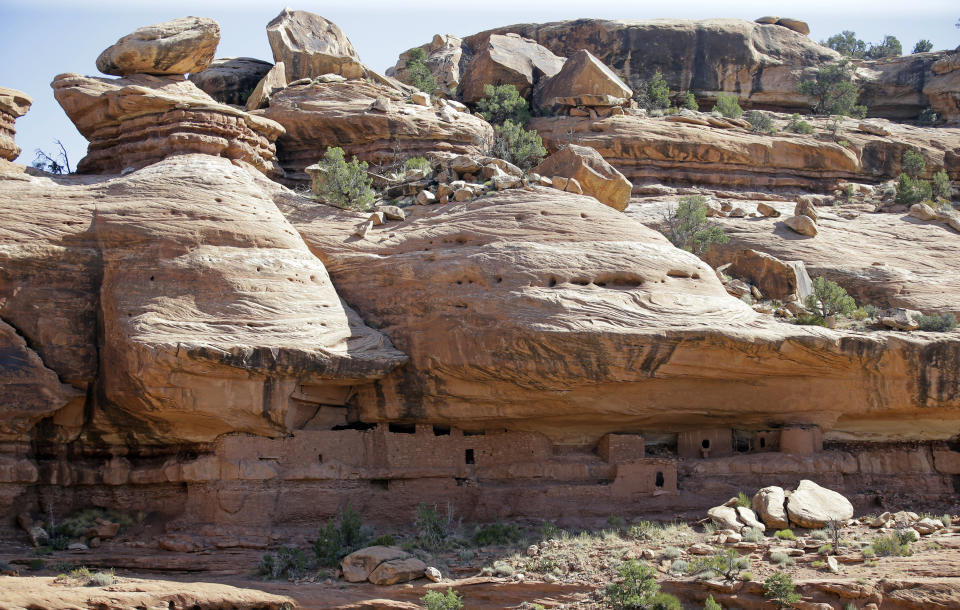'They've threatened your hearts': Trump shrinks two national monuments in Utah

President Trump flew to Utah Monday to announce that he is cutting some two million acres from two national monuments in the state to make way for oil drilling, mining, and other development.
Trump signed two presidential proclamations during his appearance, one removing protection from about 85 percent Bears Ears National Monument, which covers 1.3 million acres and was created by Barack Obama in late 2016. Grand Staircase Escalante, which covers 1.9 million acres and was created by President Bill Clinton in 1996, will be cut by roughly half.
“With the action I’m taking today, we will not only give back your voice over the use of this land; we will also restore your access and your enjoyment,” Trump said during a speech in Salt Lake City. “Public lands will once again be for public use. Because we know that people who are free to use their land and enjoy their land are the people most determined to conserve their land.”
In a moment reminiscent of Trump’s campaign rallies, the Rolling Stones’s “You Can’t Always Get What You Want” blasted through the sound system after he signed the proclamations.

The Republican president touted the decision as a victory for state’s rights and economic development. He has accused his predecessors of undermining the oil and gas industries by blocking off unnecessarily large swathes of land. But critics say the move shows a lack of concern for combating climate change, protecting the environment and preserving America’s natural beauty for future generations. Indian tribes say the Bears Ears land includes sites of religious and archaeological importance.
Trump argued that residents of Utah know how to take care of their land far better than bureaucrats in Washington, D.C. He said Americans should put their national treasures to “great and wonderful use.”
“Your timeless bond with the outdoors should not be replaced with the whims of regulators thousands and thousands of miles away,” he said. “They don’t know your land and truly they don’t care for your land like you do.”
Introducing Trump, Sen. Orrin Hatch, R-Utah, said that he had been blindsided by Obama’s national monument designation of Bears Ears: “So I asked for [Trump’s] help in fixing this disaster. Without hesitation, he looked at me square in the eye and said, ‘We’ll fix it.’ For the next several months, I worked closely with the president and the White House on a plan to reign in the federal overreach at Bears Ears and the Grand Staircase.”

Native American communities were outraged by the announcement because several tribes consider Bears Ears sacred. The Hopi, Navajo, Ute, Ute Mountain Ute, and Zuni tribal governments have already organized to save Bears Ears — arguing that “at the very least,” Trump should have consulted with their tribes.
Natalie Landreth, an attorney with the Native American Rights Fund, said in a statement that the core issue surrounding Bears Ears is tribal sovereignty and self-determination.
“The Five Tribes that advocated tirelessly to create this monument did so to protect their ancient and modern cultural and spiritual importance,” Landreth said. “The fact that it is being revoked without any consultation, or even concern, for the Tribes is offensive.”
Anticipating this controversy, Trump expressed gratitude to members of the local Navajo community who attended his speech: “Really appreciate it. We are profoundly honored by your presence here today.”

National monuments protect public land of historic, scenic or environmental significance from certain kinds of development. Congress establishes national parks, but the president can designate national monuments under the Antiquities Act, which was signed into law by President Theodore Roosevelt, a Republican and ardent environmentalist, in 1906.
“These abuses of the Antiquities Act have not just threatened your local economies; they’re threatened your very way of life. They’ve threatened your hearts,” Trump told the crowd. He asserted that a national monument designation prevents local communities from hunting or fishing or grazing livestock on the land. But the U.S. Forest Service says that hunting, fishing and grazing is already permitted throughout most of the monuments’ area.
Back in April, Trump ordered the Interior Department to review the 27 national monuments designated by previous presidents to see which designations he could overturn or reduce. A key item on Trump’s agenda is reversing any steps taken by Obama to protect the environment.
“As many of you know, past administrations have severely abused the purpose and spirit and intent of a century-old law,” Trump said.

Before the announcement, Rhea Suh, the president of the Natural Resources Defense Council, condemned the Trump’s plans as “unprecedented” and “illegal.” She said presidents use the Antiquities Act to create national monuments so special lands and bodies of water can be protected for future Americans.
“This president thinks he can use it to destroy them, grabbing the iconic landscapes and marine areas all Americans own, and handing them over to polluters and private interests. He does not have that authority. We will stand up for the millions of people who’ve asked the Trump administration to preserve — and not rip apart — our national monuments,” Suh said. “What’s next, President Trump — the Grand Canyon? See you in court.”
Similarly, Gene Karpinski, the the president of the League of Conservation Voters, condemned Trump’s actions as the biggest attack on parks and public lands in U.S. history. He said in a statement that the administration is going beyond its legal authority, ignoring public outcry over archaeological treasures and undoing the hard work of Native American groups to protect their sacred sites.
“By opening up these national monuments to oil, gas and coal speculators, the Trump administration is proving once again that they only care about padding the pockets of their polluter allies,” Karpinski said. “An attack on one national park or monument is an attack on them all, threatening our outdoor recreation economy and undermining our nation’s commitment to protecting our natural heritage for future generations.”
Read more from Yahoo News:



